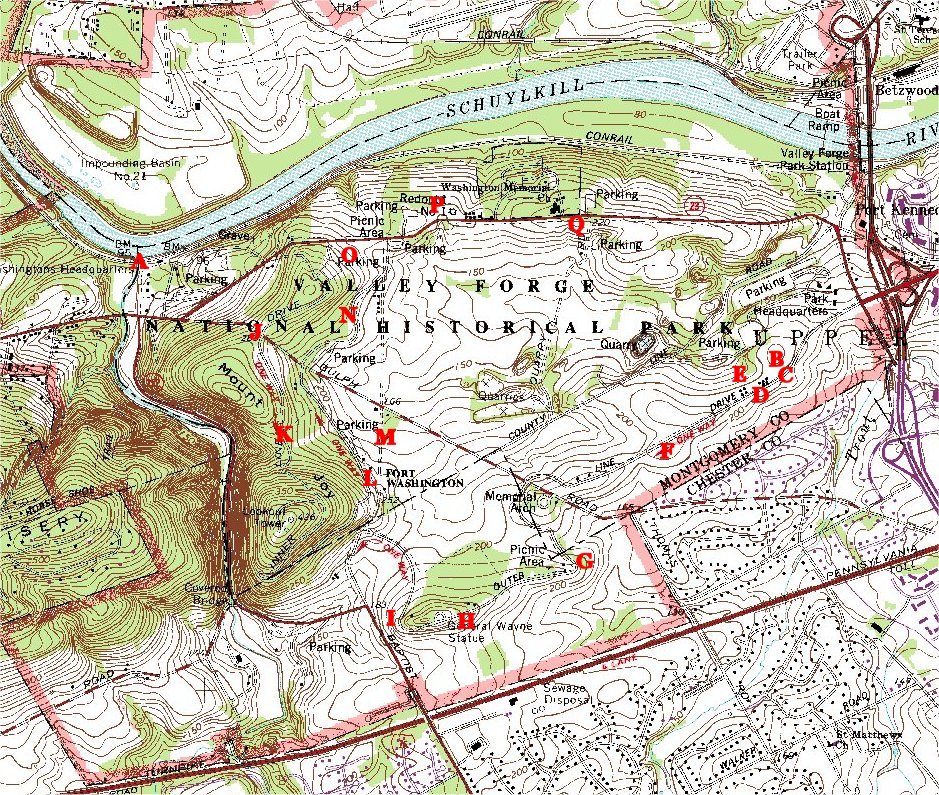
Valley Forge
Winter Quarters 1777-78
On December 8, 1777, when the skirmishes at Whitemarsh were coming to a close, it was well past time for Washington's army to go into winter quarters. Although it may seem quaint today, winter quarters were a practical necessity of 18th century warfare. Supply was complicated by winter weather, and the rigors of winter campaigning were too difficult on the health of poorly clothed and poorly nourished soldiers. Wilmington was considered, as was dispersing the army through Pennsylvania, but Washington wanted to stay near Philadelphia in order to hinder British supply efforts. He considered remaining at Whitemarsh, but Howe's attack showed that the site was vulnerable to surprise attack.
So a site slightly more distant from Philadelphia was selected, and the army arrived there - at Valley Forge - on December 19th. Here, Washington could protect the nearby fertile farmland and valuable ironworks. Because it was on the opposite side of the Schuylkill, the British would have required a time consuming river crossing to conduct an attack, and a gentle south-facing ridge provided the American army good fields of fire. Mount Joy, a larger hill in the western part of the camp, was an easily defensible area to fall back upon in an emergency. Earthworks added to the camp's strength, and spies reported to Howe that Valley Forge was too strong to attack.
Even without an attack there were plenty of difficulties. Snow soon covered the ground, hindering the construction of the log huts. Although weather hindered supply efforts, poor administration was an even greater problem, and as troops went days without eating anything of substance, Washington wondered whether he could keep his borderline mutinous army intact. Living in cramped and unsanitary conditions was difficult on the men's health, and numerous troops were sent outside the camp to "hospitals", which bore little resemblance to their modern counterparts. Twelve thousand men entered Valley Forge that December, and perhaps 2,000 of them died.
But as difficult as the winter was, and as many myths as surround Valley Forge, it should be remembered that good things did happen at there. Despite the intrigues of legislators and officers like Thomas Conway, Washington was not replaced by the incompetent hero of Saratoga, Horatio Gates. Nathaniel Greene was made quartermaster, and he vastly improved the supply situation. News of the French alliance arrived, and a German pseudo-aristocrat, "Baron von" Steuben, trained the army to a near European standard, as would be demonstrated at Barren Hill - then more convincingly at the battle of Monmouth. Despite the difficulties, perseverance had paid off, and a legend had begun.
Areas
Northern Area and Grand Parade

The letters on the map roughly correspond with the letters under the captions of most pictures. Please compare this map with the national park map. The eastern or left flank of the encampment appears to be curiously "in the air", meaning it is not anchored on a strong geographical feature. However, although not verified, an earthwork may have existed in the area just east of the park headquarters where there is now a cloverleaf, and another work may have existed at the eastern end of the northern ridge where Rt. 23 turns right, or south, to the park entrance. When combined with the awkwardness and danger that any attacking Brits would have incurred from having the Schuylkill at their backs led Washington to believe that the flank was safe.
Links
Valley Forge NHP The Making and Remaking of a National Symbol An online book detailing the preservation of the encampment and the controversies surrounding it. Although not military history strictly speaking, it gives valuable information about the site and its interpretations and myths, past and present, with topics including the reconstructed huts, alleged gravesites, Washington's HQ, and the many issues surrounding the chapel.
Valley Forge National Park see specifically http://data2.itc.nps.gov/parks/vafo/ppMaps/VAFOmap1%2Epdf
Clash of Arms - maker of the wargames Brandywine and Germantown and 1777: The Year of the Hangman - Ed Wimble, designer of the campaign game gave me invaluable help on this section of the website, as well as with other sections dealing with the 1777 campaign.
All content is copyright 2004 by John Hamill. All rights are reserved. No portion may be copied, retransmitted, reposted, duplicated, or used without express written permission.